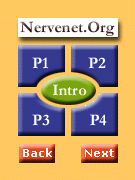




 |
 |
 |
 |
 |
|
|

|
|||
|
|
|||
|
Principal Investigator/Program Director Williams, Robert W. |
|||
| Rationale Why have we begun this ambitious project? Our primary purpose is to provide resources that are needed to efficiently and precisely map QTLs that influence CNS structure. Our first three projects generate the phenotypes and quantitative traits, and we also need to analyze the corresponding genotypes. Until now, mapping quantitative traits has been a cottage industry. A research group working within the constraints of a typical R01 grant budget can barely afford the 50,000 genotypes required to analyze 200400 F2 animals. Each group must also generate its own set of animals, genotypes, and phenotypes—a massive undertaking when quantitative neurohistology is involved. This extremely inefficient method only hinders QTL mapping. Furthermore, QTLs mapped with this small-scale approach always have poor positional precision (see explanation below). An unavoidable consequence is that the prospects of cloning QTLs by a positional candidate approach are usually very dim. The Genotyping and Mouse Colony Core is extremely valuable because we will do this onerous work for a very large sample of animals, so other researchers will not waste time and effort they would otherwise have to expend in breeding mice and processing tissue, at least in the context of neuroanatomical analysis of the CNS. Instead, they can focus on the quantitative analysis of the vast quantity of images and data that will be available in the MBL and the Neurogenetics Tool Box. By genotyping such a large genetic cross and then placing the results on the web, together with large collections of "virtual" slides, we will free other scientists from the budget and time constraints that would otherwise continue to hamper quantitative neuroanatomical studies. We hope that scientists who use these resources will share their results so that the appropriate data on phenotype and genotypes can be added to the expanding database on variation of the mouse CNS housed at |
|||
| The External Advisory Board | |||
| Institutional Support for this Program Project | |||
| Conclusion | |||